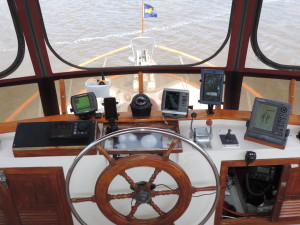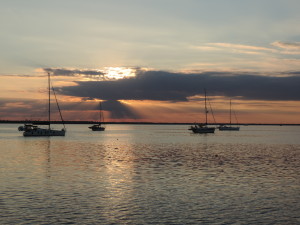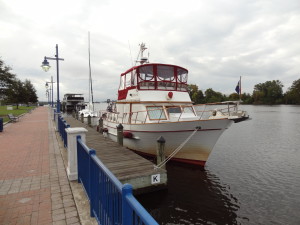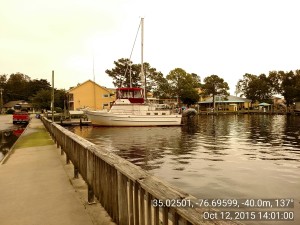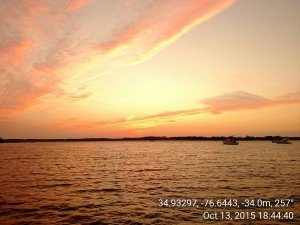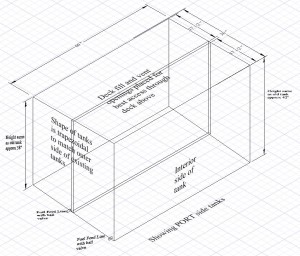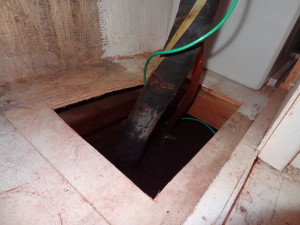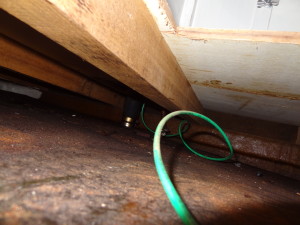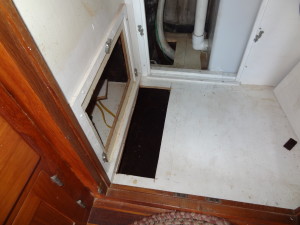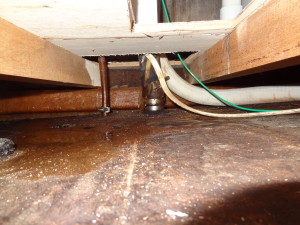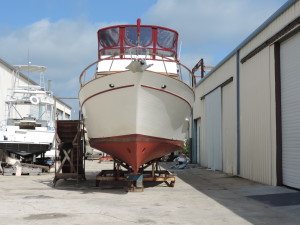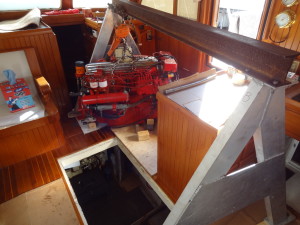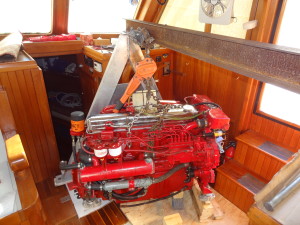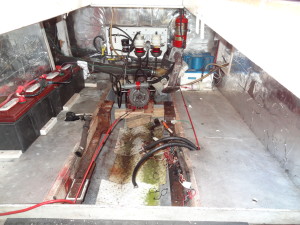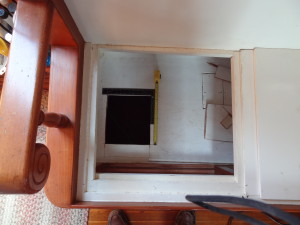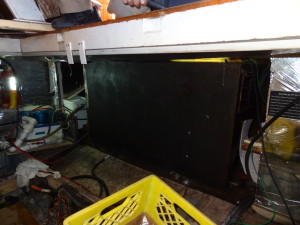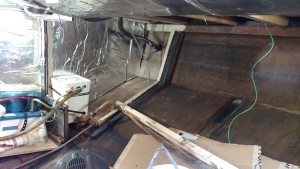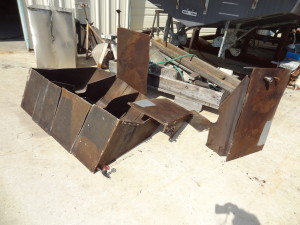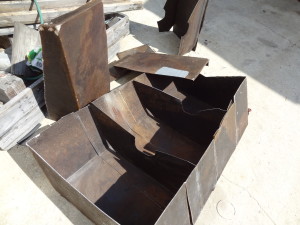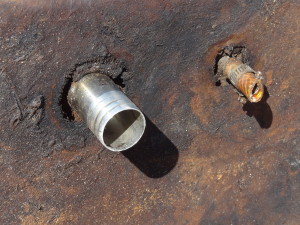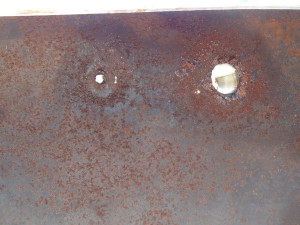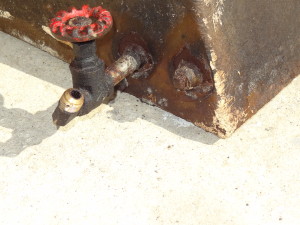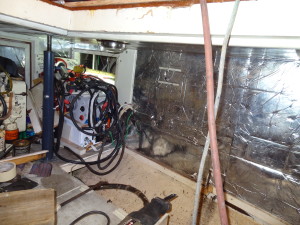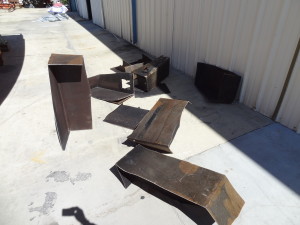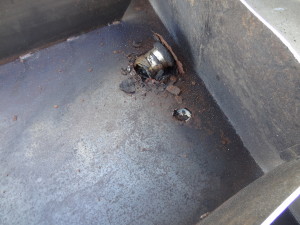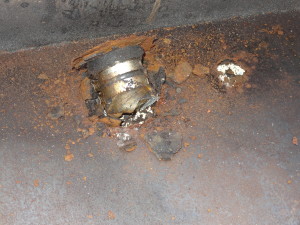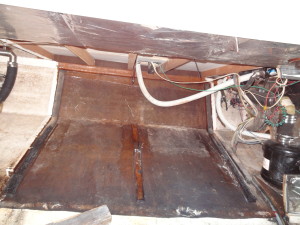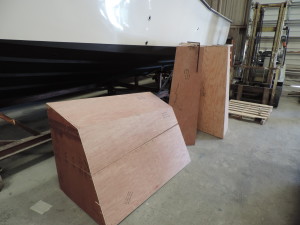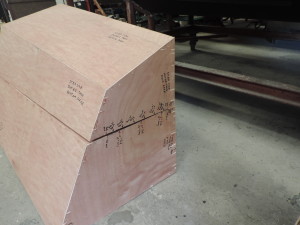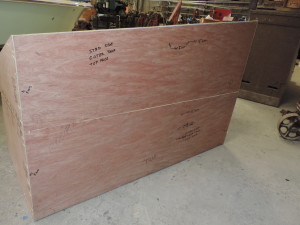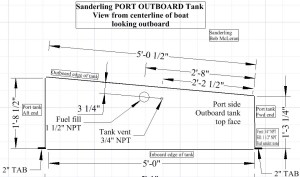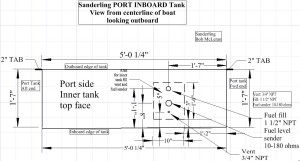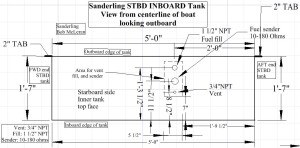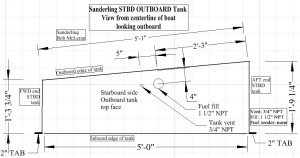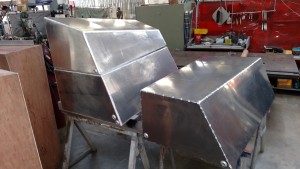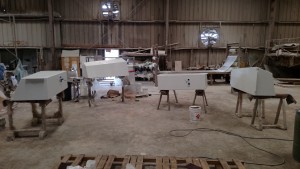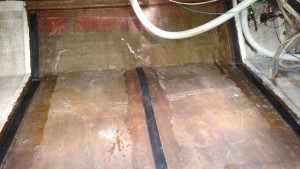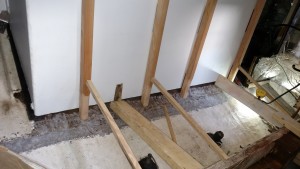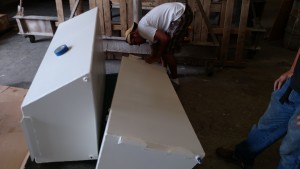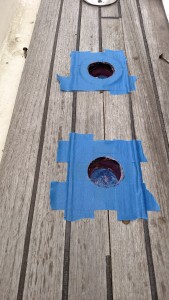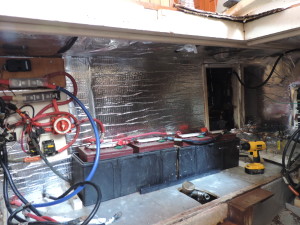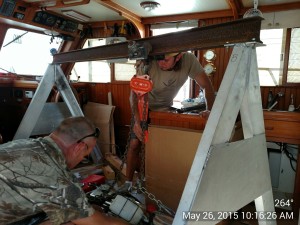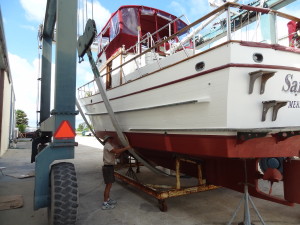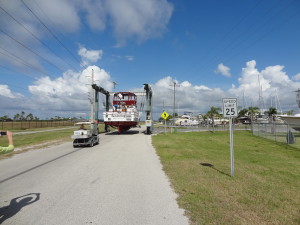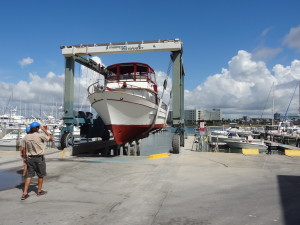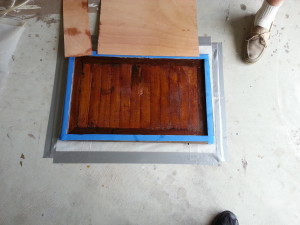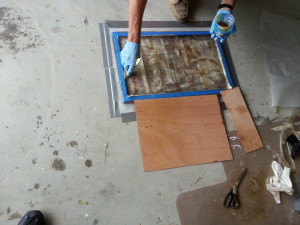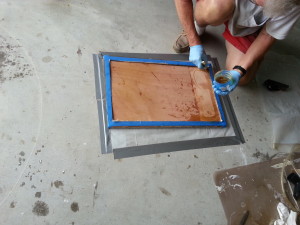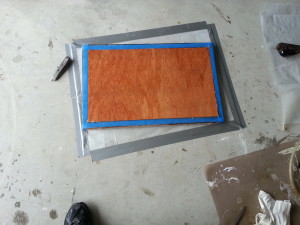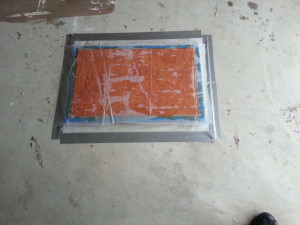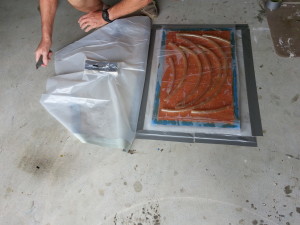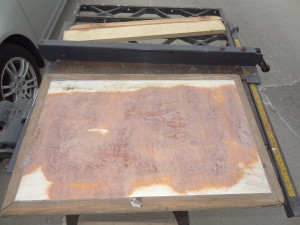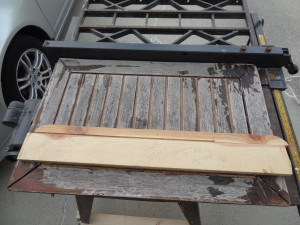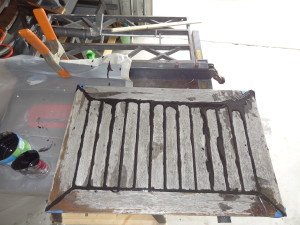Here’s a link to the PDF file which you can download and use for some initial calculations:
You will find a lot of helpful information at this blog by a very experienced cruiser:
The more I thought about this topic, the more I realized that there’s little I can contribute to what was originally posted by a gentleman-boater named Captn Wil (Andrews) on the fore-runner of the Trawlers-and-Trawlering List in 1998. Captn Wil operated a Krogen 42 out of Oriental, North Carolina, for a number of years. His experiences (and tests) with anchors of various kinds and with actually anchoring in the waters of North Carolina and Chesapeake Bay resulted in a series of posts that are still highly regarded as THE definitive non-commercial “treatise” on anchoring. He also, BTW, is well known for his fuel filtration studies and the system he designed for onboard fuel polishing (see, Captn Wil’s Fuel Polishing System) .
1. Anchoring Introduction
1.1. This section will try to introduce some terms, definitions, and stuff which will be used throughout these presentations. I’ll define them here so we won’t need to take time and space to define them as they are used later. You may want to save them for reference later on.
1.2. In my technical writings I like to use text formatting and diagrams to make things easier to understand. I really do believe that a picture is worth a thousand words. Unfortunately, I hear from users that text formatting does not always get received well by all browsers. I’ll try to simulate text formatting with what’s available in normal ASCII characters.
1.3. I don’t know how to attach a vector drawing (or any other graphics) to E-Mail. If someone knows how to do that, I’ll try to include diagrams of some of the points as we go along.
1.4. I’ll try to number things so that identifying them for discussion will be easy. I’ll just make up a numbering system for this strange E-Mail format as we go along. As you can see, I’ve started this system. The first number will be the Article number followed by Subject, etc. Hope it will be clear as we proceed.
1.5.1 Anchor System : All of the equipment which holds the boat to the bottom. It is made up of Anchor, Anchor Rode, Boat, Attachment points, and Bottom.
1.5.2 Scope: (The distance from the Anchor attachment point on the boat along the anchor rode line to the anchor) divided by (The vertical distance from the Anchor attachment point to the Anchor). Note with care that the vertical distance goes from the attachment point on the boat to the anchor. This distance must include the depth of penetration of the anchor, not just the depth of the water. In a right triangle with the anchor being the point of perspective, scope is the hypotenuse / opposite side. (What a wonderful place for a diagram)
1.5.3 Rode: All of the stuff which attaches the anchor to the boat.
Fluke : The sharp part(s) that hopefully sticks into the bottom.
Shank: The long skinny part that runs from the Rode to the flukes.
Stock: The part which runs perpendicular to the flukes. It is that round piece which tries to keep the anchor horizontal.
Crown: The two little flat pieces between the flukes – often inclined toward the shank.
Of course all anchors don’t have all those parts.
1.6 Mathematical Notation: We are not able to show all normal mathematical symbols with the standard ASCII codes , so programmers have come up with some shorthand for some of the standard symbols. Here are the ones we’ll be using.
A * B means A times B.
A^B means A raised to the Power of B.
I’ll present direct information gathered from repeatable tests I have conducted.
Conclusions drawn from those tests.
Information from tests by others.
And a few opinions of my own. I’ll make sure you know which are facts and which are opinions.
I’ve tested anchors on purpose in mud and by accident in sand and clay. I know something about anchors in those bottoms. I have not tested anchors in coral, weeds, rock, etc. I don’t have facts about anchor performance in those bottoms. My opinions about anchoring in these latter bottom would just be speculation, therefor, I’ll not give opinions about them.
Just to get things started, I’ll end this first epistle with CaptnWil’s First Law. The next edition will cover some topics which will improve the holding capacity of any anchoring system in any situation.
Unlike natural laws which cannot be disputed, on some rare occasions (generally after a few drinks), some have disputed some of CaptnWil’s Laws, but you can be assured that CaptnWil’s Laws are based on natural laws of physics, geometry, etc.
1.10 CaptnWil Law No 1. : USE ENOUGH ANCHOR
You should notice right off the bat that ANCHOR is singular and not plural. Note this well. In any situation where two anchors are set on two rodes, ALL THE LOAD WILL BE ON ONE ANCHOR ALMOST ALL OF THE TIME This is a physical fact, but we don’t even need to present the mathematical proof because you can prove it for yourself right now. Get a small diameter line about six feet long. Tie a small loop in the middle of the line. Consider that the loop is where two rodes are attached to your boat. Tie each of the ends of the line to opposite ends of a yardstick. Lay this whole business on the floor. Keep the yardstick in a fixed position. Put your finger in the loop, pretending you are the boat, and pull back so both lines are tight. Move the small loop left and right. You will notice that there is only one place where BOTH LINES ARE TIGHT. Unless you can keep your boat in one spot, ALL THE LOAD COMES ON ONE LINE ALMOST ALL OF THE TIME. Multiple anchor sets have some uses, but increasing your anchoring capacity is not one of them. That means that you cannot rely on using two “normal anchors” to increase your anchor capacity for storm protection. The safety of your boat relies on the capacity of ONE ANCHOR. Ain’t fair, is it? At least one post indicates that this fact is not unknown to all — thank God — but for those who didn’t know this fact, consider it well.
In closing this session, let me emphasize that the only anchor which can secure your boat must be attached to your boat and stuck in the bottom. It does no good in your anchor locker.
2.1 First MistakeMy friends have heard CaptnWil say, “This is the first mistake I’ve ever made” a lot. You’ve heard it for the first time, but likely not the last. This whole thing should be titled, “Anchoring”, not “Anchors.” Anchors are but one part of anchoring and we’re trying to cover the whole subject.
2.2 CaptnWil’s Second Law
You must Answer What Questions before you can Answer How Questions.
Using some formal procedures developed in the computer programming field can help us get to the answers in a most efficient manner. Those general procedures are called, “Top Down Design, and Step Wise Refinement.” That means, start with the most general part of the problem 96 at the top 96 and proceed down to the most detailed part of the problem, refining each step along the way — then go back and refine each step as needed..
In this case the first “What” is, “What must I do to keep my boat attached to one spot on the bottom?”
The Top Down Design starts here by stating the first “How.” Attach an anchor rode to the boat on one end and an anchor on the other end with the anchor stuck into the bottom. From this general statement We’ll develop some detailed information and data to help solve the whole problem.
2.3 Loads
When the wind blows, the current runs, and the waves come up, loads are transmitted to the anchoring system. If any part of the anchoring system fails, the entire system fails. Our solution must include each part of the system. Some are pretty obvious. Some have been obscure. We’ll try to look at them all.20
2.4 Penetration
Except in situations which cannot be described as “anchoring”, penetration of the bottom by the anchor is the single overriding issue in all anchoring problems. While at the moment, this may seem obvious, you’ll discover that most of us in many sad situations have ignored it. Remember, Penetration! Penetration! Penetration!
This is so important that while the following is not quite a CaptnWil Law, it is a CaptnWil Saying.
With proper penetration, most any anchor will hold your boat. Without proper penetration, no anchor will hold your boat.
You did get the emphasis on the word, “proper.”
2.5 The Bottom
Our next most important issue is the bottom. The holding capacity of any anchoring system is limited by the physical makeup of the bottom in which we stick our anchor. This is the part most people overlook. The whole anchoring solution involves the engineering disciplines of Soil Mechanics, Mechanical Engineering, and some stuff from Aeronautical Engineering.
The load applied by the anchor. Unless the bottom can take the load, it doesn’t make any difference how strong the anchor is or how big it is. As an extreme example, you can hang the worlds largest anchor in air and the air won’t have enough resistance to hold your boat.
2.6 The Rode
The performance of our system is greatly affected by the rode we connect to boat and anchor. As we go along, you may be surprised about some of the unusual ways the rode affects the anchoring system. It did me.
2.7 The Anchor
Mercy, the anchor is the last item the fool mentioned. While its importance cannot be over stated, it should be considered only after the basics described above have been investigated. After that investigation, the selection of the particular anchor will be a very simple matter. You just need to find some idiot to go out and test anchors under the conditions you expect or go test them yourself.
2.8 Where to Start
We need to start by trying to determine just what loads will be put on our anchoring system. I first found the most common formula used for this purpose in a little publication by Rule Industries written by Mr. Robert Danforth Ogg of Danforth fame. I later was advised that it is the formula used by the US Navy.
In addition, it is helpful to know just what force your own boat can exert. This information helps you make a good judgement about how good your anchor will hold. I consider the information in “Propeller Handbook” by Dave Gerr to be invaluable to any boater and especially to Trawler folk. Mr Gerr has provided a formula to compute the pounds of thrust of your propeller.
To make things easier, I long ago expanded these two equations into tables. Since that time, these tables have been used by my friends and me in finding solutions to serious anchoring questions. Questions like Hurricane Protection.
[I’ve created a spreadsheet in PDF format with WIND LOAD TABLES and MAXIMUM THRUST PROVIDED BY BOAT PROPELLERS which is easier to read than the tables Captn Wil included in his emails. Here’s the link (also at the beginning of this page). Wind load tables and prop thrust. ]
I hope you can at least read them and figure out where the columns go. If you copy the tables into a text editor with RTF capabilities, you can make the format acceptable. To help you format the stuff, I offer the following.
In the first two tables — the Wind Force Tables — The first column is the Square Feet of that part of the boat exposed to the wind. The top Row is the wind velocity in knots, and each of the other entries are pounds of pressure exerted on the boat.
In the Propeller table: The Shaft Horse Power is the first column. The top Row is the propeller diameter, and each other entry is the maximum pounds of thrust to the water.
**********************************************
Now that we have most of the basics down, we’ll get into the meat of the subject next time.
CaptnWil
AfterSail
New Bern NC
Anchoring 301
Mon, 26 Jan 1998 21:01:51 -0500
3.0 War Stories
Evelyn (my wife) had almost divorced me (well, she didn’t speak to me for a very long time) when I sold our 45-ft. Bristol sailboat and started looking for a Trawler. She had suffered during the delivery voyage from Miami through eight guests on a new (to us) boat, engine over-heating, and engine stopping due to clogged fuel filters. We survived it all and on the last day out before berthing in Mitchell Creek, we dropped anchor in tranquil Cedar Creek, just off Adams Creek on the ICW in North Carolina.
As a sailboat captain, I knew how to anchor. I had read all the Danforth stuff, and all of Chapman’s stuff. From Danforth, I knew that you put six feet of chain between the nylon rode and anchor, lower the anchor hand over hand to the bottom and slowly back away. When you increased the RPM and the anchor held, you knew you were set for the duration. I knew it worked because I had done it many hundreds of times. For the new Trawler, I had spent a lot of money for a Danforth Deepset anchor. The Trawler came with a CQR, 200 ft. of chain rode and 200 ft. of nylon rode. I really had a good anchoring system.
On this delightful North Carolina late afternoon in May, I lowered the Deepset to the bottom, looking forward to the Scotch and Soda on the marvelous aft-deck. Evelyn was preparing the drinks as I eased the transmission into reverse to back down on the anchor. I would only increase the RPM when the nylon rode came tight Just as a safety precaution, I asked Evelyn to keep a lookout over the stern.
If you don’t know what female screams about crab pots! — “STOP!” — “you’re going aground!” — “what are you doing!?”, you haven’t spent much time as Captain with a wife as a First Mate? If you have, you know exactly what was going on. The Damned anchor would not set — the anchor rode would not come tight we were going toward shore and aground with alarming speed.
Not to worry. “Evelyn, if you’ll just hold the wheel, I’ll retrieve the Danforth and set the CQR.” It was not all the mess from the black gunk that got all over everything when I retrieved the Danforth that was so bad, it was the paper towels and commands of not to get that mess in the pilot house that made this such a trial. But the CQR would keep the Scotch and Sodas safe and available in short order. This time I’d use the all chain rode and guarantee the anchor would set.
After another bout with paper towels, mud, etc, the CQR was overboard and we were moving astern to set it. You must believe that female screams will get your attention. I really believe they are the substance civilization is made of. With the screams, I stopped the boat thought about it decided to leave things as they were. After all, the winds were light and predicted to stay light the ice in the scotch and sodas was melting, and I couldn’t abide anymore screams. To be sure the anchor would “soak in.”
If this were a true soap opera, I’d now tell you about storms and high winds, but the winds did not come up, and we slept the sleep of the exhausted. I retrieved the chain and CQR next morning and wondered to myself why neither anchor had PENETRATED the bottom and set.
Later with the hurricane season fast approaching, I set out to survey my new “hurricane hole,” Mitchell Creek. The water measured a little over five feet. I deployed two anchors set at 45 degrees off the port and starboard sides of the bow. I slowly payed out 300 feet of rode (scope of 60) and then put the transmission in reverse. I waited for the line to come tight, and waited. I had sense enough this time not to wait for screams of crab post and things. I took a deep breath, swallowed hard, and realized that after all these years, I didn’t know a damned thing about anchoring. That was not so scary, what was scary was that I had done it all by the book. Didn’t anyone know anything about anchoring? That was the day I became an anchor tester. I tested every anchor I could beg, borrow, or steal in Mitchell Creek. I tested Danforths, Bruces, CQRs, and Northhills. Nothing would PENETRATE the bottom in Mitchell Creek. Why??? Well, Dummy, inspect the bottom and find out why. I found out that I could push a ten ft. piece of PVC pipe out of sight by hand into the bottom of Mitchell Creek. It was soft, oozy, black, mud.
3.1 Beginning To See The Light
Were all those anchors worthless? Had those manufacturers lied to me? Some of them rated their anchors at more than 1000 lbs. of pull. All of them said that the anchor I had tried was satisfactory for my 42 ft. Kadey Krogen. And then the light dawned. They didn’t say anything about what kind of bottom was necessary for their anchors to work. They didn’t say anything about the bottom. They talked about rode and anchor and scope and chain. Gentle reader, I remind you again, PENETRATION! PENETRATION! PENETRATION!
This is a biggie. Mark it in red.
HOW FAR MUST THE ANCHOR PENETRATE?
The anchor must penetrate until it finds material with enough integrity to hold the load applied to it by the anchor. How far is that? In good hard sand, it may be six inches. In Mitchell Creek, it is TEN FEET! In San Francisco Bay, it may be TWENTY FEET.
How can I tell if my anchor penetrated far enough? Test it.
3.2 Test It
Find those tables that were so hard to distribute over the Internet for the next part of this discussion.
A sailboat captain may have an excuse for his anchor dragging, but a trawler captain does not. First of all consider a sailboat with a 30 hp engine which has a 12-inch propeller. Consider that the boat has 125 sq. ft. exposed to the wind. From the thrust table you will see that in forward gear the maximum thrust he could get would be 612 pounds. In reverse he might get 300 pounds. Look at the “Load on Boats Due To Winds” table using a Cd of 0.70 and find that the load on his boat is 267 pounds at 30 knots. When he backs down on his anchor to full RPM, he can’t put much more pressure on the anchor than a 30 knot wind. It should be no secret why sailboats regularly start to drag anchor at 25 knots.
My Krogen 42 has a 28-inch propeller with a 135-hp engine. From the table, in forward gear I can get about 2580 pounds of thrust and a strain gauge verifies the table to be accurate. I also get most of that in reverse. Consider that my exposed surface to the wind is something like 200 sq. ft. Using the wind table with a Cd of 1.0 you can see that I can test my anchor for a wind in excess of 60 knots. Since I have a means for such a test, I can have no excuse for my anchor dragging.
IF YOU CAN MOVE YOUR ANCHOR WITH YOUR TRAWLER, YOUR ANCHOR DID NOT PENETRATE TO SAFE BOTTOM.
If you make that test on every anchor set, you will get some big surprises. You’ll also learn a lot about the bottom. Most of the time, you’ll also be horrified about how little your anchor penetrated.
All of this means that for any anchors we are likely to carry on our boats, there is a limited range of bottom conditions where the anchors will penetrate. While not described above, a very hard bottom — rock, coral, etc. — is at one end of the scale. Soft mud is at the other end.
We’ll look at our options to increase our chance of penetrating the bottom next time.
CaptnWil
AfterSail
New Bern NC
Anchoring 401
Tue, 3 Feb 1998 21:52:53 -0500
In this session we’ll get so close to the fire that you will be in danger of getting burned. This session will reveal some of the things I learned from others and confirmed by my own tests as well as things learned from the tests alone. I feel sure that you already know some of them, but I suspect that some will surprise you as much as they surprised me.
4.1 Bottoms
I discovered that a great majority of the places I want to anchor have a mud bottom. This is especially true of storm anchorages. Upon reflection, this should not have been a surprise. After all, when we want to have a quiet anchorage or a storm protected anchorage, we go up creeks, into protected coves, and other places where wind and current are minimum. When current slows down, the solids settle to the bottom and over eons of time becomes thick silt. This is no mystery, that’s how deltas and bars are made.
This IS especially true of the east coast of the US from Chesapeake Bay to the South Carolina border. It is almost a law in the sounds of North Carolina which have no lunar tides – only wind tides. But this situation in not limited to these areas. It is true anywhere current slows down.
As prevalent as this condition is, it is not a condition which can be assumed. Parts of the south shore of Albermarle Sound and Alligator River in North Carolina have some of the hardest sand and clay bottoms I have ever seen.
My belated discovery came because of the terrible time I was having trying to make anchors hold. I was having a few problems in open water, but it was just impossible where the damned mud was. The problem was that mud was in every hurricane hole I found.
My, only if it would hold in mud, and I couldn’t make a single anchor do that. In addition, I was having a hard time setting the Deep Set anchor anywhere. It was in the pursuit of trying to set the Deep Set that I got the first help in anchoring in mud.
4.2 Heresy
I called Max Schultz, the chief engineer for Rule Industries and complained that I couldn’t set his Deep Set Anchor. Take a deep breath! Get a drink! You won’t believe what he said.
Max: REMOVE THE CHAIN FROM THE ANCHOR RODE!
CaptnWil: Do What?
Max: REMOVE THE CHAIN FROM THE ANCHOR RODE!
CaptnWil: You’re crazy!
Max: If you don’t want to set the anchor, forget it!
I didn’t believe him then, but I tried it. Guess what? He was right. Since that time I have made many tests with many different anchors. All of the anchors I have tested set better without ANY CHAIN. That is important, but remember, its not just setting we’re after, we are after PENETRATION. The most important part is this:
ANY ANCHOR WILL PENETRATE BETTER WITHOUT CHAIN
There’s a bit more before you go out and try it. The chain does prevent the bottom from eating away your nylon rode. I know because I anchored for two days with nothing but nylon rode. The Deep Set held fine, but the end of the rode looked like rats had been at it for the whole time. What then goes between anchor and nylon rode?
4.3 Cable goes between the anchor and rode.
I don’t really know why the chain hinders an anchor from penetrating, but I suspect it has to do with all the stuff it picks up as it moves along the bottom. If you have ever anchored in mud, you know how filthy the chain is when you retrieve it. Cable, on the other hand, comes up clean. The cable offers even less resistance to the anchor penetrating than does the nylon rode. If your anchor will penetrate at all, it will do it better with cable.
There is a down side to cable. It will kill you if you try to handle it under load. You must not try to handle it when you retrieve the anchor. The solution is to attach a line of comfortable size (3/8 to 1/2″) along side of the cable about three-feet longer than the cable and attached to the nylon rode on one end and the anchor attachment on the other. When you bring the cable aboard, handle the line instead of the cable.
Cable will not solve all your anchoring problems, but it will increase the efficiency of any anchor you use.
4.4 Increasing Anchor Capacity
Under actual conditions, the most serious loads are shock loads, and these can cause your anchoring system to fail. The other side of the coin is that removing the shock loads can increase the capacity of your system.
When I make presentations in person, I demonstrate the effect of a shock absorber by the use of a hand-scale, hammer, nylon line, and rubber bands. I attach a hammer to the scale by a three foot nylon line. I then drop the hammer the three feet and read the pounds on the scale. The scale reads twenty. Next I attach the hammer to three feet of rubber bands attached to the scale. When the hammer is now dropped, the scale reads two pounds. In addition, the rubber bands have stretched to about six feet before returning to their original length. The result is obvious, the peak load is reduced. Note that the total work remained the same, it just took longer which put less load on your anchor. Now how do you get rubber bands into your anchor rode? I haven’t found out how you can put rubber bands into an anchoring system, but you can put a shock absorber into the system.
Good new nylon line will stretch about 20% under its design load and return to its original length when the load is withdrawn. That means that a 100-ft. line will stretch 20 ft. under its design load. That much movement provides a lot of shock absorbing. The problem is that the shock load comes long before your normal anchor rode has stretched very far at all. After all, you have selected your anchor rode to be strong enough under the most extreme conditions. You even size it a little bigger to be safe. You need to have a line which will stretch before much load is applied, but will be strong enough to take all the load. Here’s what to do:
1. For nylon rodes, always use three-strand nylon instead of braided nylon. The three-strand has the better stretch characteristics.
2. If you use chain rode, use the shock absorber described in (3) below.
3. Install a shock absorber beside your main rode. If your main rode is 5/8-inch nylon, lay a 3/8-inch nylon line beside it 10-percent shorter than your main anchor rode. This system should be considered anytime severe weather is expected. It can save your boat. I have used this method in my hurricane anchoring set-up. For that service, I use a one-inch nylon main rode with a ╜-inch shock absorber. When the winds blew 50 knots, the one-inch rode never came tight, it just got almost straight.
4. Never use chain alone in severe conditions. In the water depths in which we anchor, it is a bad myth that the chain gives any shock absorbing at all. To prove this, just let out 100 feet of chain in ten feet of water – set the anchor – go forward on it ten feet – then reverse the transmission and let the boat come up tight against the chain. I used to clear stumps this way with a jeep in my youth. I also broke a chip out of my chain stopper when Evelyn didn’t get the transmission out of gear before the chain came tight – but that’s another story I can’t tell you.
*******************************
That’s enough fire for this time. Next time we’ll get into some specific
anchor tests. I’ll give places and name names. Only the fittest survive!
CaptnWil
AfterSail
New Bern NC
Trawler World List: Anchoring 4.01 and a half
Anchoring 4.01 and a half
Thu, 5 Feb 1998 18:01:30 -0500
I knew the cable issue would give all pause. Let me go back to the beginning. I’m an anchor tester. I also have an engineering background. I’ve made all the conclusions about what crowns and flukes and chain and stuff does to the anchor, BUT THE FINAL WORD is how did it test? I just put the dog on the track and watch him run.
I cannot generate any test data to demonstrate that weight of any kind, including chain, at the end of the shank of a Danforth, or any other anchor helps it penetrate. All of my tests demonstrate that anything on the end of the shank make the penetration job harder for the anchor. The lesson is that the less you can put there, the better. The cable offers the least resistance to penetration than any item I have found. That does not mean that something better is not available – I just haven’t found it. I’m sure that chain doesn’t help.
We’ll get to Fortresses and MAXes and Danforths in some detail in 501, but for now consider that Danforth has always advised putting six-feet of chain between the anchor and rode. It was when the chain was removed from the deep-set anchor that it would set at all. I had tried six-feet, twenty-feet, and fifty-feet. The only purpose Danforth ever had for the chain was to prevent chafe – and it will do that.
Most of the time I am able to make some engineering sense out of the results of the tests I run. I must confess that this chain, cable, penetration thing defies explanation. I just know what happens.
CaptnWil
AfterSail
New Bern NC
Trawler World List: Anchoring 501
Anchoring 501
Fri, 6 Feb 1998 09:58:12 -0500
5.1 At The Beginning
Anchors and Women have many similar characteristics. If you handle them properly they’ll serve you well and save your life. Handle them poorly and they will dump you and never look back as you slowly fade away.
Each anchor has a set of characteristics which are unique to it. One of the most important things an anchor tester can do is take the time to learn what the anchor wants. It is even more important for the captain who trusts his boat and the lives of his crew and passengers to the success of the anchor to know every detail about what the anchor needs to perform at its best.
I find that most of the tests I read about and which I observe fail on this score. The testers just throw the anchors out and try to come to a definitive judgement about the performance of the anchor. In all of the tests I do, I test one anchor at the time. I test it many times. It is seldom that I can conclude a test on a single anchor in one week. It takes me that long to get to know the anchor well – it’s kinda like the courtship of a beautiful lady. I want every anchor to be great. I want to give it every chance I can. I want to have confidence in what I say about the anchor.
5.2 Hard Lesson Learned
Most everything in the boating world is measured by ratios. Hull speed is 1.35 times the square root of the waterline length – the cost of a yacht goes up as the cube of the length – and on and on. Most of us have made the mistake of believing that anchors also follow ratios – big boat, big anchor – little boat, little anchor. It is a true generalization that a smaller boat requires less holding power than a larger boat, but that does not transmit directly to the size of the anchor.
Many anchor manufacturers have gone on the assumption that the anchor performance would be proportional to the proportional size change of the anchor. Anchor users have accepted this premise without question, and in many cases to our ruin.
Here’s the awful, ugly truth. The bottom does not obey the law of ratios. If it’s ten feet to good holding bottom for a 60-foot boat, it’s ten feet to good holding bottom for a 30-foot boat. Both boats must get their anchor to good holding or they will drag. It took me a very long time to discover this very elementary fact.
It does not matter how the anchor penetrates to good bottom, it’s just necessary that it does. The anchor weighing 30,000-pounds on an aircraft carrier penetrates to good bottom by its sheer weight. Most anchors on pleasure craft of the size we have penetrate by being pulled to good bottom by their shape and proportion. The weight is just what is necessary to make the thing. You can believe that the 30,000-pound anchor weights less in proportion to the weight of the air craft carrier than the weight of the 45-pound CQR does to your 42-foot trawler. The term “Light Weight Anchor” is just another illustration of the ratio thing. It’s a term defined in relation to what a man can pick up, not anything about the ratio of its weight to the weight of the boat.
The issue here is that if the anchor penetrates by weight, changing its weight will not affect its performance so long as the weight is not reduced below the amount necessary to allow the anchor to penetrate. That’s the major reason that anchors know as “Navy Anchors” do well on large ships, but poorly on yachts. They’re made big enough and heavy enough when deployed on ships to penetrate to good bottom.
On the other-hand, changing anything on an anchor which penetrates by shape and proportion can, and often does, change the performance of the anchor completely. It is unsafe and unwise to extrapolate results from these kinds of anchors. The is especially true when the anchor size in question is sufficient to cause the anchor to penetrate. Trying to extrapolate those results to an anchor of the same shape, but whose weight is not enough to cause the anchor to penetrate is a constant concern. The results described below are for the particular size or weight anchor used in the test. Different results might be obtained with different sizes of the same anchors. Whenever you see figures of load capacity quoted by an anchor manufacturer, ask that manufacturer if each anchor size was tested to arrive at the quoted figures, or if the figures are ratios based on testing only one anchor.
5.3 Bottoms
The anchor sticks in the Bottom and the Bottom must accept all loads transferred to it by the anchor.
1. Good Bottom
Good bottom can be penetrated by the anchor with little effort and has enough structural integrity to hold the load transferred by the anchor. The amount of penetration required for structural integrity is not great. It is what we all look for. The anchor goes in easy, comes out easy, and is clean when it comes up.
2. Soft Bottom
For our purposes, soft bottom is a very special kind. It is generally referred to as “mud”, but that doesn’t really describe it. A more descriptive term might be “Silt.”
The characteristics of this bottom are produced by solids dropping out of solution with the water as moving water slows down. This water originally came from some far away place, maybe even the mountains. Long ago in its journey, the big stuff (rocks, gravel, etc.) have already settled out. Now all that is left is very fine, generally black, matter. This stuff has been deposited at this one spot for as long as conditions have remained the same. It may have been doing this routine since God made this body of water. You’ll get a depth sounder reading far above any solid material in the bottom.
The important thing about this bottom is that this silt has absolutely no structural integrity at all. In our Mitchell Creek, this layer is ten-feet deep.
3. Hard Bottom
Bottom which is so hard that it is difficult to get an anchor to penetrate it at all. The obvious examples of this bottom are, rock and, coral. Very hard sand and clay can also fall into this category.
4. Other Bottoms
I lump everything else into this category because I don’t have any test results in them. They include grass and kelp. One of the toughest “Other” bottoms I have encountered is the leaf covered bottom in Washington DC.
5.3 Anchor Types
I break anchor types into two classes, (1) fixed, and (2) adjustable.
1. Fixed
Except for one anchor I’ll surprise you with later, until about 1990, all of the anchors we could use on our yachts were of the fixed type. Those that I have tested include, Danforth Standard, Danforth Hi- Tensile, Danforth Deep Set, Danforth Soft Bottom, Danforth Plow, CQR, Bruce, Northhill.
All of these anchors are effective in one kind of bottom. All except the Danforth Soft Bottom are effective in “Good Bottoms.” They will not penetrate deeply in “Soft Bottoms’, and are difficult to set in “Hard Bottoms.” The characteristics of these anchors is why I went on my anchor search and anchor tests.
My tests indicate that each of these anchors have their individual characteristics, strengths, and weaknesses in “Good Bottoms.” I’ll list a few.
Bruce
Good:
This is the fastest setting anchor I have used in the fixed anchors. It doesn’t much care how you deploy it – you can just chunk it over the side. I used it for a long time as an emergency anchor for stopping the boat upon engine failure at bridge openings, etc.
While it doesn’t penetrate very far, it resists pulling out when the direction of the pull changes.
It is not finicky about scope.
Bad
It has the least holding capacity for its weight of all the anchors I have tested.
When it is overloaded and drags, it tends to bury the rode end of the shank and pull the claw out of the ground. When it drags, the claw is most often filled with bottom material and the anchor will not reset.
My test were made with the 44-pound anchor. Increasing the size and therefore the weight could make this anchor penetrate better. It is said that this was developed to anchor the oil well platforms in the North Sea. Those anchors weighed tons instead of pounds. I have no doubt that in the sizes first designed, they penetrated deeply and held their design loads very will. Its characteristics in small sizes demonstrate the dangers of reducing the physical size and using a ratio to assume its holding capacity in the smaller size. I have seem a very large Bruce, maybe 500 pounds, on a very large yacht (100 + feet). Of course I haven’t tested that monster, but I’d bet it would do well in that size.
CQR, Danforth Plow
Also called “The Plow.” For you City Slickers, it should be called a “Double Bottom Plow.” In good bottom, when properly set, this is an exceptional anchor. This anchor must be set very carefully and a very large scope used. Its great worth is that most of the time its capacity is the same after it drags as before. It does just what it’s called, it “Plows.” Almost all other anchors have little or no holding capacity once they drag.
I feel strongly that the great reputation of this anchor comes from its ability to retain capacity after it drags. I suspect that the use of long lengths of chain came into play because of this anchor, trying to satisfy its very finicky setting requirements. This was just one means of trying to overcome the problem with setting.
As indicated above, this anchor does not break out often, and that can fool you about how well the anchor has penetrated. If you don’t back down on this anchor hard – full RPM – you may think it is secure when it isn’t. I had a frightful experience with this in the Keys. Using a scope of ten, it took me ten tries to get the anchor to hold at 1500 RPM. It would hold at below that RPM every time, but would start to slowly plow its way across the harbor at 1500 RPM. Made for an uneasy night.
The two plow anchors I tested were a 45-pound CQR and a P-1900 Danforth. The Danforth outperformed the CQR because it had larger flukes (plow) than the CQR.
I spent about three hours trying to set two of these anchors in “Hard Bottom” on the ICW north of Beaufort SC. I finally found some good bottom, set the anchor, and survived a night of high winds. It was the same 45-pound CQR that wouldn’t set in “Soft Bottom” in Cedar Creek which started me on the anchor testing thing.
Danforths
Except for the Danforth Plow described above, all of the Danforths are similar in design and you know them very well. They do well in “Good Bottoms” and are better than most in “Hard Bottoms.” These characteristics should not be surprising because they were designed by Mr. Danforth in the late 30s to work in sand. Later they were deployed on landing crafts in WWII. Where do landing crafts need anchors? On SAND beaches. These anchors pulled the landing crafts off the beach after discharging their loads (men or material). They helped win the War and keep us free. I have a special place in my heart for the man who designed this anchor and the anchor that did the work.
The original Deep Set had a very small crown set at a very small angle. This seemed to contribute to its difficult setting characteristics. I have forgotten what size Deep Set I tested, but it was the largest I could buy. In fact, I bought two of the things for a lot of money. I notice that the new Deep Sets have conventional Danforth crowns.
I have found no difference in the Hi-Tensile and Standard versions in holding power or characteristics. I’m sure the strengths differ.
Danforth Soft Bottom
After my discussion with Max Schultz about the Deep Set problem, I called him about the “Mud” problem. He was kind enough to send me a prototype “Mud” anchor. It became known as the “Soft Bottom.” It was the first anchor I ever tried that would penetrate “Soft Bottom.” More about this anchor later. I don’t think it is made now.
Northhill
Once this anchor failed in “Soft Bottom”, I did not test it again. I hear that it is good in rocks – not rock.
5.4 Fixed Anchor Conclusions
It’s been some years since I tested any of those fixed type anchors because my first requirement of an anchor is that it hold in “Soft Bottom.” Those early test left me in despair. My main concern was how to save my boat in hurricanes and other storm conditions. I didn’t know what I was searching for, but knew I had to find a “Mud” anchor. Those results next time.
CaptnWil
AfterSail
New Bern NC
Trawler World List: Anchoring – 601
Anchoring – 601
Sat, 7 Feb 1998 23:28:05 -0500
6.1 The Yellow Brick Road
Much like Dorothy on the yellow brick road, the path in this anchoring mess was not straight. Facts came in bits and pieces – forward at times and backward often. I pursued every anchor manufacturer I could find a phone number for. I was sure I had hit pay-dirt when Max Schultz sent me his “mud anchor.” It held to full RPM in Mitchell Creek. This thing wasn’t so bad after all.
When I asked Max why the “mud anchor” worked, he explained very gently that Mr. Danforth had discovered by empirical means that the angle of the fluke needed to be thirty-two degrees to set and hold in sand. Later Rule Industries people had discovered by empirical means that the fluke angle needed to penetrate soft bottom was forty-five degrees. That is what set the “mud anchor” apart from the “sand anchor.” Mercy! This thing is simple. Use an anchor with forty-five degree flukes and no chain and you will be secure. New concepts, all problems solved. WRONG!
This is important! This is the whole story! For an anchor to hold:
THE ANGLE OF THE DANGLE IS INVERSELY PROPORTIONALLY TO THE DENSITY OF THE BOTTOM THE DANGLE IS STUCK IN!
I learned the sad truth that a Danforth style anchor with a fluke angle of forty-five degrees, which did just great in “Soft Bottom”, just bounced over the sand bottom of Alligator River. A 45-pound CQR, on the other hand, did just fine. The implication of all of this was that I needed to carry TWO SETS OF ANCHORS – one set for “Good Bottom” and one set for “Soft Bottom.” How much more despair was I in for?
6.2 Light At The End Of The Tunnel
No, it wasn’t the light of the train coming the other way. It was Dan Wolfe who runs Fortress Anchors.
CaptnWil: I want to talk to you about the capacity of your anchors in mud.
Dan: In mud our anchors have eleven percent of rated holding power in sand.
CaptnWil: You’re who I want to talk to. What are you doing about mud anchors?
Dan: We’re developing a “mud” anchor as we speak.
CaptnWil: I interested, can I test it?
Dan: Yes. By the way, we’ll have AN ADJUSTABLE ANCHOR SOON.
CaptnWil: I’ve discovered that chain doesn’t help.
Dan: Yes! Use CABLE. We’ll market it soon.
What a day! Fortress did go on to make an adjustable anchor, but never did market the cable. The day of the modern adjustable anchor was born. The Fortress can be adjusted for sand, etc. by setting the flukes at an angle of 32-degrees. It can be adjusted for “Soft Bottom” at 45-degrees. It has similar characteristics to a Danforth which isn’t surprising once you see its shape. There are material differences which I’ll discuss a little later on.
Dan and I arranged to test anchors together for some time, and for a while the Fortress was the only adjustable anchor available. It was also the only one which would penetrate “Soft Bottom.” Both with Dan and in tests I conducted alone, the effectiveness of the cable was demonstrated over and over.
A new member to the adjustable anchor group appeared a couple of years ago. This is the MAX manufactured by Creative Marine. It can be adjusted to three positions instead of two. It doesn’t look like anything you have ever seen before. It is an ugly brute and if you dare to put it on your bow-roller you must believe in it because its only redeeming quality must be how well it anchors.
6.3 Not Rocket Science
We’ll cover both of these anchors in some detail a little later, but first let me set this straight. Designing an anchor to penetrate “Soft Bottom” is no longer a mystery. An individual can make any Danforth anchor into a “Soft Bottom” anchor, and in fact, I have a friend who did just that instead of buying a $500.00 Fortress for hurricane protection. It worked so well that he almost didn’t get it up from the bottom.
If you want to modify a Danforth anchor to be a “Soft Bottom” anchor, just get a file and cut away at the bearing point which stops the fluke until the fluke angle to the shank is 45-degrees. Modifying other style anchors is not practical because of their construction.
6.4 We Didn’t Invent Intelligence
A while back, I commented on the “Modern Adjustable Anchor.” The first adjustable anchor is many hundreds of years old, and I just discovered it a couple of years ago. Some facts from history nagged at me about this anchoring problem. For centuries great and small sailing ships had not only navigated around the globe without aids to navigation, etc., but had anchored more or less successfully in all kinds of unknown bottoms. I could find no mention of general anchoring problems from the historical things I read.
Everyone knows that those anchors have had poor results on yachts in smaller sizes. In my travels, I couldn’t get those anchors off my mind. At the annoyance of Evelyn, I’d stop and measure everyone I found either by pacing or later by carrying a small tape (some kind of nut?). Most of them seemed to be about the same size – ten to twelve feet long with five to six-foot flukes.
You know how they look. The stock is at the very top. “Why is that?”, I ask. To keep it stable. “Yes, but it would be more stable down at the flukes,” I say. BUT THEN THE FLUKES COULD NOT ROTATE DOWN INTO THE BOTTOM! “You mean the softer the bottom, the deeper the anchor will PENETRATE?” Yes, dummy, otherwise it wouldn’t be adjustable and could be used in only one kind of bottom, which wouldn’t work since we sail all around the world
“But why does it rotate into the bottom?” Because the resistance of the bottom working on the angle of the fluke pushes it into the bottom when horizontal load is put on it.
“Why is it ten feet long?” Well, dummy, if it rotates 45 degrees into the bottom, the crown will be seven feet (and change) UNDER THE BOTTOM, and the flukes will be 10 ft. under the bottom. That’s enough penetration for any place we sail.
“Thank you, Teacher, but why don’t they work on my 40-ft. boat?” My, you are dumb. You shortened the shank to 3 feet. Don’t you know the anchor must penetrate the bottom just as far for your 40-ft. boat as for the 200-ft. ship? Sometimes I’m a slow learner.
6.5 Fortress
In tests, many different sized Fortresses have penetrated ten measured feet under the bottom. Fortress is one manufacturer who tests each anchor to get the ratings it advertises. My first real “Soft Bottom” test on this anchor took place in Club Foot Creek. Dan had disturbed me greatly when he said that you can’t really tell much about the test unless you can ultimately make the anchor drag. Well, so be it, I deployed a small FX-11. That means that if the anchor were made of steel, it would weigh 11 pounds. I deployed it carefully in the lull just before a blow. I backed down on it to full RPM, then the wind came up to about 25 knots and the strain gauge showed just under 2,000 pounds. This little anchor finally moved and I shut down just as the wind died.
This anchor had passed my first test, and I tested the size I would normally use on the AfterSail (FX-37) in every bottom I could find. When set in proper configuration (32 or 45-degree fluke angle) the anchor performs marvelously, but its like a woman, you must do it her way.
The anchor is made of aluminum and is very light. This makes it a marvel to handle. My FX-37 weights less than twenty pounds. While that is a very great characteristic, it also means that it will swim very easily in the water. If it swims, it won’t set. Here’s how to set it:
1. Stop the boat. Really stop it.
2. Pay out the rode hand over hand and set the crown of the anchor on the bottom gently.
3. Lay the anchor down and take all tension off the anchor rode while the boat slowly backs away until the scope on the rode is about two.
4. This is critical. Hold the rode firmly in your hand and snatch the rode toward you with vigor. Real hard, with real vigor. Do that until you feel the anchor trip into the bottom. You’ll know when that happens because of the resistance in your hand. If it never comes up tight against your jerk, take the anchor in, clean it off and try again.
5. Now let the boat back off until the scope is about 5. Secure the rode and back down hard. You will be securely set.
6. The anchor will tell you if you are in the right configuration. If the bottom is too hard for your setting, the anchor will just bounce across the bottom. You can see and feel this condition on the rode. If the bottom is too soft for your configuration, the anchor will drag before you can apply much pressure to it.
7. Uniquely as far as I know, Fortress is the only anchor manufacturer who provides “mud palms” with their anchor. These are two plates which bolt to the crown of the anchor increasing the crown size. Since the crown is what trips the anchor flukes into the bottom, these palms are intended to be an aid to setting the anchor in “Soft Bottom.” Be warned though, any crown at all is a necessary evil. The crown is a hindrance to the anchor penetrating after it is once set. What we’d really like is a big, “disappearing” crown. Make every effort to set the anchor without using the mud palms.
8. If the bottom is soft, you’ll have the devil of a time getting the anchor up unless you know how. This will be covered after the discussion on the MAX since both present the same kind of problem.
9. The Fortress can be stowed as is or disassembled for storage below. This feature allows you to take as large a storm anchor with you as you can pay for. Remember, use enough anchor.
10. One thing the Fortress is not. It is not an emergency stopping anchor. Remember you must lay it down and put no pressure on it at all until you get it started to penetrate the bottom. If you throw it out in an emergency underway, it’ll just swim beautifully behind you as you slam into the bridge.
6.6 MAX
The Bad News
The MAX is not only ugly, it does not stow easily except on a bow roller. And not any old bow roller at that. The anchor has a single, very long fluke that looks something akin to an old fashioned steam shovel hoe crossed with face of the Tim Woodman in the Wizard of Oz. If your bow roller isn’t long enough, the fluke will ruin the bow of your boat. You really can’t imagine what it looks like until you see it, and you probably won’t believe what you saw when you do.
1. The anchor is adjustable to three positions: hard, soft, very soft. Its performance is extraordinary in all but very hard bottoms. I could not set it at all on the south shore of Albemarle Sound. I did set the Fortress at this location.
2. It sets very quickly with no special attention as to deployment. It rivals the Bruce in how quickly it sets.
3. It sets on short scope. Once when my engine overheated in Rebellion Reach in Charleston Harbor, it set in 50 feet of water on a scope of two in an emergency anchoring situation. There was about a three-knot current. When the overheating problem had been solved, my Ideal windless would not pull the anchor out of the bottom.
4. When overloaded, it just seems to slowly move along still stuck into the bottom. Often you have a hard time determining that it is really moving. When this happens on the AfterSail, I know it is set in the wrong configuration because otherwise I can’t move it.
5. The adjustment from one position to the other is made by changing the position of a bolt in the two-part shank. This adjustment arrangement gives the shank a funny appearance, but I have not been able to damage it through some torture tests. You must loosen both bolts in the shank and take one completely out. Then rotate the shank to the desired location and reinstall the bolt and nut. (What a place for a diagram – well, on second thought, I probably couldn’t draw the thing anyway.)
The danger here is losing the bolt or nut. I insist that at least three spare sets be kept on board all the time. If you lose the bolt and/or nut, you’ll not have much of an anchor.
6. The anchor is heavy. The one I use on AfterSail weighs 55 pounds. The weight by itself is no problem if you have a power windless.
7. Due to the configuration of the shank and fluke, pushing the anchor off the roller and returning it to the roller needs to be practiced before actually using the anchor. You’ll find that there is just one way to do it. If you do it that way, it won’t be a problem: otherwise you’ll use a lot of foul language. The problem is that there is a quadrant sort of thing half-way up the shank where the position adjustment is made. That quadrant insists on getting stuck on the bow-roller unless you do it just right.
I have a friend who has sailed around much of the world who knows he is a better sailor than I am, and thinks he’s a better engineer. We took Chuck and his wife on our final test of the MAX in the Chesapeake. We were gone for about 10 days and when we started, Chuck had nothing but contempt for the MAX. He had manners enough not to be obvious about it, but I knew.
The purpose for going to the Chesapeake is that after an anchor passes the test in Mitchell Creek, the final exam is Fishing Bay. For those of you not familiar with the area, Fishing Bay is a cove in the Piankatank River. It has depths of about 20 feet with as difficult a bottom as I have ever explored. For years I didn’t know what the bottom was because I never got anything back on the anchor. Any anchor would seem to set, but under load the anchor would drag. I almost lost my first sailboat there.
Since the anchor and rode always came up clean there, I assumed that bottom was something hard. When I was finishing the tests on the Fortress, I finally put the anchor in “Soft Bottom” setting. It set with a thud. It was the strangest soft bottom I ever encountered.
Fast forward to the MAX test. Chuck insisted that he would handle the anchor while I handled the throttle. We put the anchor in the middle position, set it properly, and started to back down. At 1600 RPM it started to move. The rode would just kinda snake from side to side as we made stern-way. I called a halt, pulled the filthy thing back on board, changed to extra soft setting and after Evelyn let me back into the Pilot House, we backed away again. This time, 2600 RPM and black smoke out the stern. Nothing moved except the prop wash. The 5/8-inch nylon line shrunk to less than ╜-inch. Chuck called out, “Bar tight!” and a new MAX convert was made. One of those ugly monsters now rides on his bow.
One of the most useful characteristics of the MAX is that it will survey the bottom for you. It brings up layers of bottom which are still intact. From the MAX, I was able to tell that the bottom in Fishing Bay is about a foot of the most awful yellow soupy gunk you have ever seen. It stinks and sticks to everything something awful (just ask Evelyn). Below that is the most beautiful white sand laced with black loam and sprinkled with small sea shells you have ever seen. At that depth, it is a perfect example of “Good Bottom.”
6.7 What It All Means
1. Unless there are conditions beyond my control, I’ll always have adjustable anchors on the AfterSail. Because the useful range of adjustable anchors is so great, and the useful range of fixed anchors is so restricted, I exclude fixed anchors entirely.
6.8 If You Go To Adjustable Anchors
There are some things common to both the Fortress and MAX.
1. They will penetrate so far in “Soft Bottom” that your windless won’t pull them out of the bottom. You must know how to bump the anchor out of the bottom with the boat. Here’s how:
1.1 Take in the rode until it is straight down – 90 degrees.
1.2 Go forward on the engine till the anchor comes up or the boat stops.
1.3 If the boat stops, take in the line as the boat moves back.
1.4 When it is again at 90 degrees, go forward on the engine.
Repeat these steps enough and the anchor will come up.
2. If you use these anchors, you must either have or install a good wash-down system. They will come up with a lot of bottom material on them. I’ve brought up stumps, logs, rocks, oyster beds, and much other assorted gunk. You’ll want to get it off the anchor before you take it on board. The strongest wash-down stream you can get is not too much.
6.9 The Cable
It’s always the cable that stirs the pot. At first, everyone wants to know why it works better than chain. Those who have used it in storm conditions stop asking. I don’t know for sure, and I don’t expect to spend time finding out. I haven’t used chain on my nylon rode since 1990. Since the results have been so spectacular, I have no interest in pursuing the matter further. I understand those who raise questions about cable – I did so myself at first. All I can suggest is that you try it and make up your own mind.
I use 3/8-inch stainless-steel cable for working cable and 5/8-inch galvanized cable for hurricane protection. I use the stainless-steel cable only because it is clean and stays bright. I have the cable made up with a thimble on each end.
I know, I know. You want to know how long the cable should be. Think about this. If the load pulls the rode straight, the length of the rode under the bottom is the scope times the penetration. If you have a scope of five and your anchor penetrates five feet, you have TWENTY-FIVE of rode under the bottom. Scary, isn’t it? I think 20 or 25 feet is a good place to start for working cable. I use fifty feet for the storm cable.
6.10 In Conclusion
I’ve named some names and given opinions on some anchors in this series. You need to know that all of the tests were done for my own personal anchoring requirements. I don’t work for, or have any interest in, any anchor company or other commercial enterprise connected with this project, and I don’t want to sell you anything
It’s at about this time in a personal presentation that I open the discussion to questions and comments from the floor. In this case, let me now open this discussion to the List.
CaptnWil
AfterSail
New Bern NC

